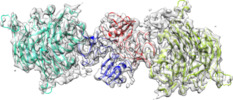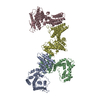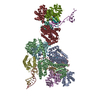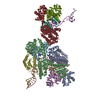+ Open data
Open data
- Basic information
Basic information
| Entry | Database: EMDB / ID: EMD-23923 | |||||||||
|---|---|---|---|---|---|---|---|---|---|---|
| Title | Cryo-EM structure of 2:2 c-MET/NK1 complex | |||||||||
 Map data Map data | Cryo-EM structure of 2:2 c-MET/NK1 complex | |||||||||
 Sample Sample |
| |||||||||
 Keywords Keywords | c-MET / HGF / receptor tyrosine kinase / SIGNALING PROTEIN | |||||||||
| Function / homology |  Function and homology information Function and homology informationregulation of p38MAPK cascade / skeletal muscle cell proliferation / negative regulation of guanyl-nucleotide exchange factor activity / hepatocyte growth factor receptor activity / regulation of branching involved in salivary gland morphogenesis by mesenchymal-epithelial signaling / Drug-mediated inhibition of MET activation / MET activates STAT3 / negative regulation of hydrogen peroxide-mediated programmed cell death / MET Receptor Activation / MET interacts with TNS proteins ...regulation of p38MAPK cascade / skeletal muscle cell proliferation / negative regulation of guanyl-nucleotide exchange factor activity / hepatocyte growth factor receptor activity / regulation of branching involved in salivary gland morphogenesis by mesenchymal-epithelial signaling / Drug-mediated inhibition of MET activation / MET activates STAT3 / negative regulation of hydrogen peroxide-mediated programmed cell death / MET Receptor Activation / MET interacts with TNS proteins / endothelial cell morphogenesis / hepatocyte growth factor receptor signaling pathway / semaphorin receptor activity / MET receptor recycling / pancreas development / MET activates PTPN11 / MET activates RAP1 and RAC1 / Sema4D mediated inhibition of cell attachment and migration / MET activates PI3K/AKT signaling / positive regulation of endothelial cell chemotaxis / negative regulation of stress fiber assembly / MET activates PTK2 signaling / positive regulation of DNA biosynthetic process / cellular response to hepatocyte growth factor stimulus / positive chemotaxis / branching morphogenesis of an epithelial tube / negative regulation of Rho protein signal transduction / negative regulation of release of cytochrome c from mitochondria / chemoattractant activity / negative regulation of thrombin-activated receptor signaling pathway / semaphorin-plexin signaling pathway / negative regulation of interleukin-6 production / myoblast proliferation / positive regulation of interleukin-10 production / epithelial to mesenchymal transition / establishment of skin barrier / positive regulation of osteoblast differentiation / Regulation of MITF-M-dependent genes involved in cell cycle and proliferation / MET activates RAS signaling / negative regulation of extrinsic apoptotic signaling pathway via death domain receptors / MECP2 regulates neuronal receptors and channels / positive regulation of microtubule polymerization / Interleukin-7 signaling / negative regulation of autophagy / cell surface receptor protein tyrosine kinase signaling pathway / basal plasma membrane / platelet alpha granule lumen / molecular function activator activity / epithelial cell proliferation / InlB-mediated entry of Listeria monocytogenes into host cell / cell chemotaxis / excitatory postsynaptic potential / growth factor activity / liver development / receptor protein-tyrosine kinase / Negative regulation of MET activity / negative regulation of inflammatory response / cell morphogenesis / neuron differentiation / Constitutive Signaling by Aberrant PI3K in Cancer / Platelet degranulation / PIP3 activates AKT signaling / mitotic cell cycle / PI5P, PP2A and IER3 Regulate PI3K/AKT Signaling / RAF/MAP kinase cascade / protein tyrosine kinase activity / Interleukin-4 and Interleukin-13 signaling / protein phosphatase binding / cell surface receptor signaling pathway / positive regulation of phosphatidylinositol 3-kinase/protein kinase B signal transduction / receptor complex / positive regulation of MAPK cascade / postsynapse / positive regulation of cell migration / signaling receptor binding / negative regulation of apoptotic process / cell surface / signal transduction / positive regulation of transcription by RNA polymerase II / extracellular space / extracellular region / ATP binding / identical protein binding / membrane / plasma membrane Similarity search - Function | |||||||||
| Biological species |  Homo sapiens (human) Homo sapiens (human) | |||||||||
| Method | single particle reconstruction / cryo EM / Resolution: 5.0 Å | |||||||||
 Authors Authors | Uchikawa E / Chen ZM | |||||||||
 Citation Citation |  Journal: Nat Commun / Year: 2021 Journal: Nat Commun / Year: 2021Title: Structural basis of the activation of c-MET receptor. Authors: Emiko Uchikawa / Zhiming Chen / Guan-Yu Xiao / Xuewu Zhang / Xiao-Chen Bai /   Abstract: The c-MET receptor is a receptor tyrosine kinase (RTK) that plays essential roles in normal cell development and motility. Aberrant activation of c-MET can lead to both tumors growth and metastatic ...The c-MET receptor is a receptor tyrosine kinase (RTK) that plays essential roles in normal cell development and motility. Aberrant activation of c-MET can lead to both tumors growth and metastatic progression of cancer cells. C-MET can be activated by either hepatocyte growth factor (HGF), or its natural isoform NK1. Here, we report the cryo-EM structures of c-MET/HGF and c-MET/NK1 complexes in the active state. The c-MET/HGF complex structure reveals that, by utilizing two distinct interfaces, one HGF molecule is sufficient to induce a specific dimerization mode of c-MET for receptor activation. The binding of heparin as well as a second HGF to the 2:1 c-MET:HGF complex further stabilize this active conformation. Distinct to HGF, NK1 forms a stable dimer, and bridges two c-METs in a symmetrical manner for activation. Collectively, our studies provide structural insights into the activation mechanisms of c-MET, and reveal how two isoforms of the same ligand use dramatically different mechanisms to activate the receptor. | |||||||||
| History |
|
- Structure visualization
Structure visualization
| Movie |
 Movie viewer Movie viewer |
|---|---|
| Structure viewer | EM map:  SurfView SurfView Molmil Molmil Jmol/JSmol Jmol/JSmol |
| Supplemental images |
- Downloads & links
Downloads & links
-EMDB archive
| Map data |  emd_23923.map.gz emd_23923.map.gz | 70.3 MB |  EMDB map data format EMDB map data format | |
|---|---|---|---|---|
| Header (meta data) |  emd-23923-v30.xml emd-23923-v30.xml emd-23923.xml emd-23923.xml | 13 KB 13 KB | Display Display |  EMDB header EMDB header |
| Images |  emd_23923.png emd_23923.png | 118.2 KB | ||
| Filedesc metadata |  emd-23923.cif.gz emd-23923.cif.gz | 5.9 KB | ||
| Archive directory |  http://ftp.pdbj.org/pub/emdb/structures/EMD-23923 http://ftp.pdbj.org/pub/emdb/structures/EMD-23923 ftp://ftp.pdbj.org/pub/emdb/structures/EMD-23923 ftp://ftp.pdbj.org/pub/emdb/structures/EMD-23923 | HTTPS FTP |
-Validation report
| Summary document |  emd_23923_validation.pdf.gz emd_23923_validation.pdf.gz | 602.4 KB | Display |  EMDB validaton report EMDB validaton report |
|---|---|---|---|---|
| Full document |  emd_23923_full_validation.pdf.gz emd_23923_full_validation.pdf.gz | 602 KB | Display | |
| Data in XML |  emd_23923_validation.xml.gz emd_23923_validation.xml.gz | 6.1 KB | Display | |
| Data in CIF |  emd_23923_validation.cif.gz emd_23923_validation.cif.gz | 7 KB | Display | |
| Arichive directory |  https://ftp.pdbj.org/pub/emdb/validation_reports/EMD-23923 https://ftp.pdbj.org/pub/emdb/validation_reports/EMD-23923 ftp://ftp.pdbj.org/pub/emdb/validation_reports/EMD-23923 ftp://ftp.pdbj.org/pub/emdb/validation_reports/EMD-23923 | HTTPS FTP |
-Related structure data
| Related structure data |  7mobMC  7mo7C  7mo8C  7mo9C  7moaC C: citing same article ( M: atomic model generated by this map |
|---|---|
| Similar structure data |
- Links
Links
| EMDB pages |  EMDB (EBI/PDBe) / EMDB (EBI/PDBe) /  EMDataResource EMDataResource |
|---|---|
| Related items in Molecule of the Month |
- Map
Map
| File |  Download / File: emd_23923.map.gz / Format: CCP4 / Size: 75.1 MB / Type: IMAGE STORED AS FLOATING POINT NUMBER (4 BYTES) Download / File: emd_23923.map.gz / Format: CCP4 / Size: 75.1 MB / Type: IMAGE STORED AS FLOATING POINT NUMBER (4 BYTES) | ||||||||||||||||||||||||||||||||||||||||||||||||||||||||||||||||||||
|---|---|---|---|---|---|---|---|---|---|---|---|---|---|---|---|---|---|---|---|---|---|---|---|---|---|---|---|---|---|---|---|---|---|---|---|---|---|---|---|---|---|---|---|---|---|---|---|---|---|---|---|---|---|---|---|---|---|---|---|---|---|---|---|---|---|---|---|---|---|
| Annotation | Cryo-EM structure of 2:2 c-MET/NK1 complex | ||||||||||||||||||||||||||||||||||||||||||||||||||||||||||||||||||||
| Projections & slices | Image control
Images are generated by Spider. | ||||||||||||||||||||||||||||||||||||||||||||||||||||||||||||||||||||
| Voxel size | X=Y=Z: 1.08 Å | ||||||||||||||||||||||||||||||||||||||||||||||||||||||||||||||||||||
| Density |
| ||||||||||||||||||||||||||||||||||||||||||||||||||||||||||||||||||||
| Symmetry | Space group: 1 | ||||||||||||||||||||||||||||||||||||||||||||||||||||||||||||||||||||
| Details | EMDB XML:
CCP4 map header:
| ||||||||||||||||||||||||||||||||||||||||||||||||||||||||||||||||||||
-Supplemental data
- Sample components
Sample components
-Entire : 2:2 c-MET/NK1 complex
| Entire | Name: 2:2 c-MET/NK1 complex |
|---|---|
| Components |
|
-Supramolecule #1: 2:2 c-MET/NK1 complex
| Supramolecule | Name: 2:2 c-MET/NK1 complex / type: complex / ID: 1 / Parent: 0 / Macromolecule list: all |
|---|---|
| Source (natural) | Organism:  Homo sapiens (human) Homo sapiens (human) |
-Macromolecule #1: Hepatocyte growth factor
| Macromolecule | Name: Hepatocyte growth factor / type: protein_or_peptide / ID: 1 / Number of copies: 2 / Enantiomer: LEVO |
|---|---|
| Source (natural) | Organism:  Homo sapiens (human) Homo sapiens (human) |
| Molecular weight | Theoretical: 24.19915 KDa |
| Recombinant expression | Organism:  Homo sapiens (human) Homo sapiens (human) |
| Sequence | String: MWVTKLLPAL LLQHVLLHLL LLPIAIPYAE GQRKRRNTIH EFKKSAKTTL IKIDPALKIK TKKVNTADQC ANRCTRNKGL PFTCKAFVF DKARKQCLWF PFNSMSSGVK KEFGHEFDLY ENKDYIRNCI IGKGRSYKGT VSITKSGIKC QPWSSMIPHE H SFLPSSYR ...String: MWVTKLLPAL LLQHVLLHLL LLPIAIPYAE GQRKRRNTIH EFKKSAKTTL IKIDPALKIK TKKVNTADQC ANRCTRNKGL PFTCKAFVF DKARKQCLWF PFNSMSSGVK KEFGHEFDLY ENKDYIRNCI IGKGRSYKGT VSITKSGIKC QPWSSMIPHE H SFLPSSYR GKDLQENYCR NPRGEEGGPW CFTSNPEVRY EVCDIPQCSE VE UniProtKB: Hepatocyte growth factor |
-Macromolecule #2: Hepatocyte growth factor receptor
| Macromolecule | Name: Hepatocyte growth factor receptor / type: protein_or_peptide / ID: 2 / Number of copies: 2 / Enantiomer: LEVO / EC number: receptor protein-tyrosine kinase |
|---|---|
| Source (natural) | Organism:  Homo sapiens (human) Homo sapiens (human) |
| Molecular weight | Theoretical: 155.720625 KDa |
| Recombinant expression | Organism:  Homo sapiens (human) Homo sapiens (human) |
| Sequence | String: MKAPAVLAPG ILVLLFTLVQ RSNGECKEAL AKSEMNVNMK YQLPNFTAET PIQNVILHEH HIFLGATNYI YVLNEEDLQK VAEYKTGPV LEHPDCFPCQ DCSSKANLSG GVWKDNINMA LVVDTYYDDQ LISCGSVNRG TCQRHVFPHN HTADIQSEVH C IFSPQIEE ...String: MKAPAVLAPG ILVLLFTLVQ RSNGECKEAL AKSEMNVNMK YQLPNFTAET PIQNVILHEH HIFLGATNYI YVLNEEDLQK VAEYKTGPV LEHPDCFPCQ DCSSKANLSG GVWKDNINMA LVVDTYYDDQ LISCGSVNRG TCQRHVFPHN HTADIQSEVH C IFSPQIEE PSQCPDCVVS ALGAKVLSSV KDRFINFFVG NTINSSYFPD HPLHSISVRR LKETKDGFMF LTDQSYIDVL PE FRDSYPI KYVHAFESNN FIYFLTVQRE TLDAQTFHTR IIRFCSINSG LHSYMEMPLE CILTEKRKKR STKKEVFNIL QAA YVSKPG AQLARQIGAS LNDDILFGVF AQSKPDSAEP MDRSAMCAFP IKYVNDFFNK IVNKNNVRCL QHFYGPNHEH CFNR TLLRN SSGCEARRDE YRTEFTTALQ RVDLFMGQFS EVLLTSISTF IKGDLTIANL GTSEGRFMQV VVSRSGPSTP HVNFL LDSH PVSPEVIVEH TLNQNGYTLV ITGKKITKIP LNGLGCRHFQ SCSQCLSAPP FVQCGWCHDK CVRSEECLSG TWTQQI CLP AIYKVFPNSA PLEGGTRLTI CGWDFGFRRN NKFDLKKTRV LLGNESCTLT LSESTMNTLK CTVGPAMNKH FNMSIII SN GHGTTQYSTF SYVDPVITSI SPKYGPMAGG TLLTLTGNYL NSGNSRHISI GGKTCTLKSV SNSILECYTP AQTISTEF A VKLKIDLANR ETSIFSYRED PIVYEIHPTK SFISGGSTIT GVGKNLNSVS VPRMVINVHE AGRNFTVACQ HRSNSEIIC CTTPSLQQLN LQLPLKTKAF FMLDGILSKY FDLIYVHNPV FKPFEKPVMI SMGNENVLEI KGNDIDPEAV KGEVLKVGNK SCENIHLHS EAVLCTVPND LLKLNSELNI EWKQAISSTV LGKVIVQPDQ NFTGLIAGVV SISTALLLLL GFFLWLKKRK Q IKDLGSEL VRYDARVHTP HLDRLVSARS VSPTTEMVSN ESVDYRATFP EDQFPNSSQN GSCRQVQYPL TDMSPILTSG DS DISSPLL QNTVHIDLSA LNPELVQAVQ HVVIGPSSLI VHFNEVIGRG HFGCVYHGTL LDNDGKKIHC AVKSLNRITD IGE VSQFLT EGIIMKDFSH PNVLSLLGIC LRSEGSPLVV LPYMKHGDLR NFIRNETHNP TVKDLIGFGL QVAKGMKYLA SKKF VHRDL AARNCMLDEK FTVKVADFGL ARDMYDKEYY SVHNKTGAKL PVKWMALESL QTQKFTTKSD VWSFGVLLWE LMTRG APPY PDVNTFDITV YLLQGRRLLQ PEYCPDPLYE VMLKCWHPKA EMRPSFSELV SRISAIFSTF IGEHYVHVNA TYVNVK CVA PYPSLLSSED NADDEVDTRP ASFWETS UniProtKB: Hepatocyte growth factor receptor |
-Experimental details
-Structure determination
| Method | cryo EM |
|---|---|
 Processing Processing | single particle reconstruction |
| Aggregation state | particle |
- Sample preparation
Sample preparation
| Buffer | pH: 7.5 |
|---|---|
| Vitrification | Cryogen name: ETHANE |
- Electron microscopy
Electron microscopy
| Microscope | FEI TITAN KRIOS |
|---|---|
| Image recording | Film or detector model: GATAN K3 BIOQUANTUM (6k x 4k) / Average electron dose: 60.0 e/Å2 |
| Electron beam | Acceleration voltage: 300 kV / Electron source:  FIELD EMISSION GUN FIELD EMISSION GUN |
| Electron optics | Illumination mode: FLOOD BEAM / Imaging mode: BRIGHT FIELD |
| Sample stage | Specimen holder model: FEI TITAN KRIOS AUTOGRID HOLDER / Cooling holder cryogen: NITROGEN |
| Experimental equipment |  Model: Titan Krios / Image courtesy: FEI Company |
 Movie
Movie Controller
Controller




























 Z (Sec.)
Z (Sec.) Y (Row.)
Y (Row.) X (Col.)
X (Col.)





















